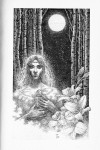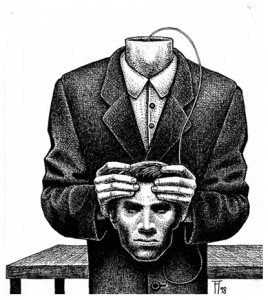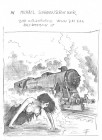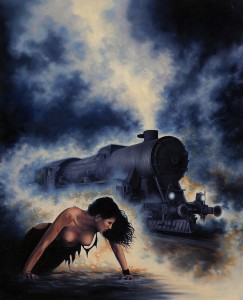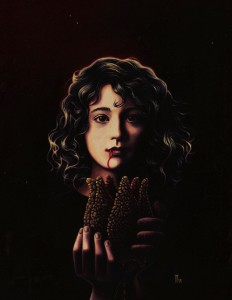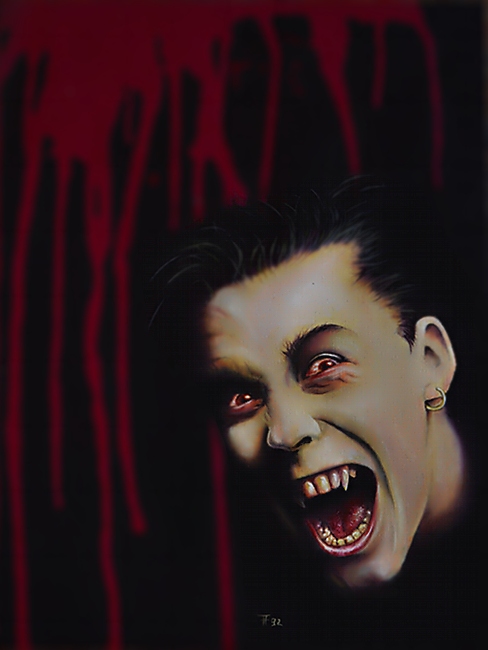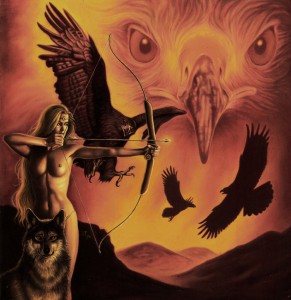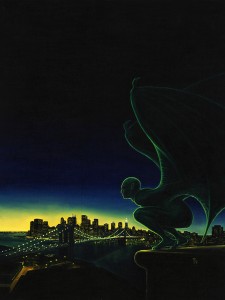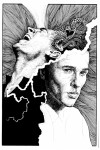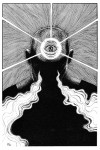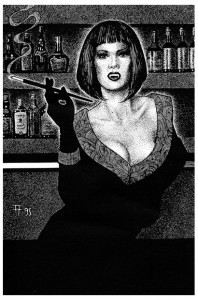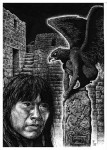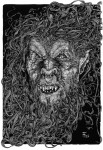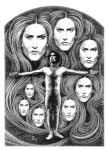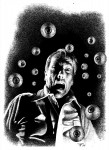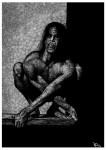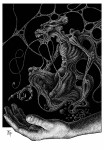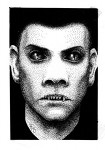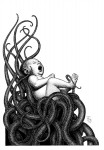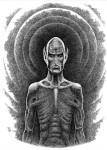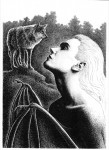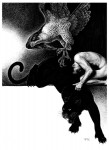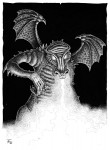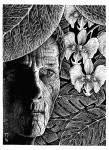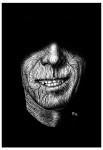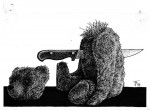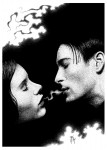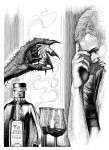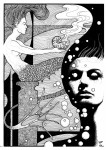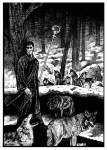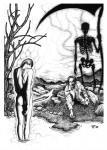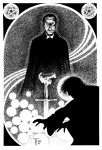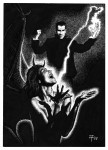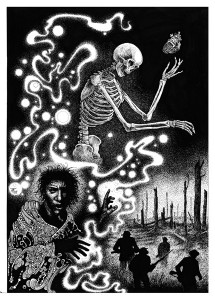Illustrations for Die Herren der Zeit (The Lords of Time) by Helmut W. Pesch, 2000
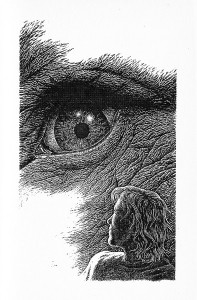 The novel, published in paperback by Bastei Lübbe, is the sequel to The Rings of Power – not quite so close to the Lord of the Rings as its predecessor (in the second part there’s a lot of time travelling going on), but still with substantial and, as in The Rings of Power, deliberately used Tolkien reminiscences.
The novel, published in paperback by Bastei Lübbe, is the sequel to The Rings of Power – not quite so close to the Lord of the Rings as its predecessor (in the second part there’s a lot of time travelling going on), but still with substantial and, as in The Rings of Power, deliberately used Tolkien reminiscences.
The original drawings are missing, therefore I scanned the book pages.
Illustrations for a John Sinclair Anniversary Paperback Edition, Part 4 (Vol. 17–21), 1998/99
- Bd. 17/1, Der Würfel des Unheils
- Bd. 18/1, Die Mörder-Blumen
- Bd. 19/3, Flucht in die Schädelwelt
- Bd. 19/4, Im Land des Vampirs
- Bd. 20/1, Die fliegenden Särge
- Bd. 20/3, Das Elexier des Teufels
- Bd. 20/4, Die Nacht der flammenden Augen
- Bd. 20/5, Der Gigant von Atlantis
- Bd. 20/8, Die Teufelsuhr
- Bd. 21/1, Myxins Entführung
- Bd. 21/2, Wer mit Gedanken töten kann
- Bd. 21/3, Der Spiegel-Dämon
- Bd. 21/5, Medusas Rache
- Bd. 21/6, Der Zombie-Bus
- Bd. 21/8, Die Bestien aus dem Geister-Sumpf
A selection of 16 out of 50 illustrations for the John Sinclair anniversary paperbacks vol. 17–21. The edition was was chronological reprint of the original horror pulp series by Jason Dark (Helmut Rellergerd). Each book included 8 novels, the interior illustrations replaced the original color covers but were created independantly from their predecessors.
Altogether I illustrated 21 volumes with 169 drawings; more images in part 1, 2 und 3.
Overview of all John Sinclair books at gruselromane.de.
Illustrations for Die Ringe der Macht (The Rings of Power) by Helmut W. Pesch & Horst von Allwörden, 1997
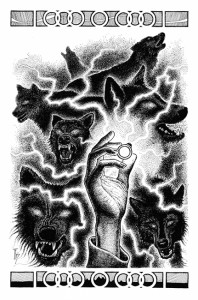 The novel was published in paperback by Bastei Lübbe paperback in 1997, and it is exactly what its title suggests: A deep bow to Tolkien.
The novel was published in paperback by Bastei Lübbe paperback in 1997, and it is exactly what its title suggests: A deep bow to Tolkien.When I read the first 100 pages of of the manuscript back then I was slightly irritated by by the extent of references to The Fellowship of the Ring, but once I had accepted the whole thing as a deliberate pastiche, and since the novel later on develops in quite another direction, my irritation abated. The authors know exactly what they do, especially Helmut W. Pesch, whose doctoral dissertation “Fantasy – Theory and History of a Literary Genre” from 1981 is the German standard reference book on the subject. Since I had read the study years ago, I was all the more glad when Bastei commissioned the illustrations for the novel.
The sequel Die Herren der Zeit (The Lords of Time) was published in 2000.
Cover Illustrations for the Pulp Series Vampira, 1992–98
- Bd. 7
- Bd. 9
- Bd. 20
- Bd. 27
- Bd. 38
- Bd. 38
- Bd. 39
- TH Bd. 9
- TH Bd. 17
- TH Bd. 1
- TH Bd. 18
- TH Bd. 37
- TH Bd. 39
- TH Bd. 47
- TH Bd. 54
- Skizze für Bd. 38
- Skizze für TH Bd. 17
- Skizze für TH Bd. 39
- Skizze für nicht realisiertes Titelbild
- dito
Vampira is a horror pulp fiction series which was published by Bastei between 1994 and 1999. It reached 110 volumes, 50 in the typical German “Heftroman” format and 60 in in the more paperback-like “Taschenheft” format and with new numbering. Vampira was created by the author Manfred Weinland and the Bastei editor Manfred Schönenbröcher. A new edition started on May 3, 2011.
During the 90s I contributed 18 cover illustrations, all of them oil paintings on cardboard, approx. 40 x 50 cm. Almost all of them (except the covers for vol. 9 and 27 which dated prior to the series) were created after brief descriptions by the editor. As the series subtitle “Dangerous – Mysterious – Erotic” suggests, the motto “sex sells” was part of the basic idea, and the covers reflect that idea (not always, though, sometimes they were allowed to be more mysterious than erotic). The most important accessory of the heroine is a shape-shifting dress, whose literal “life of its own” justifies even the most absurd outfit …
The series’ title, “Vampira”, is not the heroine’s name but just a catchy word that summs up what this is all about (and maybe it’s a little hommage to Maila Nurmi). The title doesn’t even appear in the novels. The protagonist’s name is Lilith Eden, a not-too-subtle hint at the series’ mythological, actually biblical, background story that uses Old Testament motives as the fall of men and Noah’s ark as well as bits and pieces from other mythologies quite inventively.
The others authors of the pictured novels (besides Manfred Weinland) are Uwe Voehl (vol. 38), Carter Jackson (Taschenheft vol. 9) and Timothy Stahl (Taschenheft Vol 17, 18, 37, 54).
Overview of the whole Vampira series at gruselromane.de
Cover: © Bastei Lübbe
Cover Illustrations for the Pulp Series Professor Zamorra, Part 2, 1994–2002
- Bd. 620
- Bd. 681
- Bd. 700
- Bd. 703
- Bd. 720
- Bd. 749
- Bd. 759
- Bd. 798
- Bd. 799
- Bd. 863
- Bd. 688
- Bd. 789
Almost half of my pulp novel cover illustrations (26 paintings) were used for the Horror/Fantasy/SciFi series Professor Zamorra, published by Bastei. You can see the first 12 examples in part 1.
The covers for vol. 620 and 759 were painted without an explicit commission, but with regard to certain characters from the series; the subsequent novels were inspired by the images. Vol. 703 and 720 (and two others I leave out) were cover illustrations I originally created for Zaubermond, they were used by Bastei for the second time. The illustrations for vol. 688, 681, 700, 749, 759, 789, 798 und 799 were based on descriptions by the main author, Werner Kurt Giesa. These descriptions could be detailed or vague, for example “something with wolves, please” (vol. 749) or “The novel is called Weresnail on a Rampage – you can do what you like, but the weresnail should resemble Jabba the Hut.” (vol. 789) (Weresnail, yes. The novel was meant as a horror parody.) Sometimes I omitted details I considered dispensible on my own authority, in the case of vol. 668, for example, a car in front of the colosseum.
Some of the novels were written by other auhors than Werner Kurt Giesa: Claudia Kern (vol. 720; with WKG: vol. 703), Timothy Stahl (vol. 749), Martin Kay (with WKG: vol. 789), Andreas Balzer (vol. 798, 799) and Christian Schwarz (vol. 863).
My last Professor Zamorra cover, Schwingen des Todes (Wings of Death), painted in 2002 after I had come back from a New York vacation, was published in 2007. Since I had started to work as an assistent curator for the Stately Museums Kassel in 2002, i was lacking time. Or maybe I just got lazy.
Werner Kurt Giesa died in 2008. This picture gallery is dedicated to him. I owe him a lot.
Übersicht über alle Professor-Zamorra-Romane bei gruselromane.de
Cover: © Bastei Lübbe
Illustrations for a John Sinclair Anniversary Paperback Edition, Part 2 (Vol. 5–11), 1994–96
- Bd. 5/1, Die Todesgondel
- Bd. 5/6, Der Unheimliche von Dartmoor
- Bd. 5/7, Die Nacht des schwarzen Drachen
- Bd. 5/8, Die Killerpuppen
- Bd. 6/8, Flugvampire greifen an
- Bd. 7/1, Im Haus des Schreckens
- Bd. 7/4, Die Totenkopf-Insel
- Bd. 7/6, Damona, Dienerin des Satans
- Bd. 7/7, Der Mörder mit dem Januskopf
- Bd. 8/7, Geister-Roulette
- Bd. 9/2, Das Mädchen von Atlantis
- Bd. 9/7, Das Dämonenauge
- Bd. 10/2, Der unheimliche Mönch
- Bd. 10/3, Der Satanist
- Bd. 10/4, Maringo, der Höllenreiter
- Bd. 10/7, Die Rückkehr des Rächers
- Bd. 9/5, Das Horror-Taxi von New York
- Bd. 10/8, Teufelstrank um Mitternacht
- Bd. 11/4, Die Horror-Reiter
- Bd. 11/8, Der Alptraum-Garten
A selection of 21 out of 32 illustrations for the John Sinclair anniversary paperbacks, vol. 5–11. The edition was chronological reprint of the original horror pulp series by Jason Dark (Helmut Rellergerd). Each book included 8 novels, the interior illustrations replaced the original color covers but were not supposed to imitate them in any way.
Altogether I illustrated 21 volumes with 169 drawings; more images in part 1, 2 und 4.
Overview of all John Sinclair books at gruselromane.de.
Illustrations for the Horror Pulp Series Dämonenland , Part 2, 1994–96
- Bd. 122, Earl Warren, Der Fluch des Inka
- Bd. 124, W.K. Giesa und Manfred Weinland, Aufbruch der Werwölfe
- Bd. 133, Fritz Leiber, Spielball der Hexen
- Bd. 134, Frank Bowman, Satans Erbe
- Bd. 136, Logan Derek, Der Augensammler
- Bd. 137, T.R. Mahn, Das Monster aus der Tiefe
- Bd. 138, R. Warner-Crozetti, Die Kapuzenmänner
- Bd. 139, Hugh Walker, Bestien der Nacht
- Bd. 142, Wolfgang Hohlbein, Das Phantom der U-Bahn
- Bd. 146, Dan Shocker, Schreckensmahl
- Bd. 152, Uwe Voehl, Im Schloss der 1000 Tode
- Bd. 153, James R. Burcette, Der Herr der Untoten
- Bd. 153, James R. Burcette, Der Herr der Untoten
- Bd. 161, James R. Burcette, Die sanften Bestien
- Bd. 164, Das Grauen von Chichen Itza
- Bd. 167, Earl Warren, Der Satansorden von Chalderon
- Bd. 169, Damian Fox, Die Spur des Drachen
- Bd. 169, Damian Fox, Die Spur des Drachen
- Bd. 172, Rebecca LaRoche, Der Dschungeldämon
- Bd. 173, W.K. Giesa und Manfred Weinland, Die Vampir-Klinik
- Bd. 173, W.K. Giesa und Manfred Weinland, Die Vampir-Klinik
- Bd. ?
- Bd. ?
- Bd. 141, Manfred Weinland, Schattenkinder
- Bd. 174, W.K. Giesa und Manfred Weinland, Draculas Rückkehr
From 1991 till 1996 I drew about 160 illustrations for the horror pulp series Dämonenland, published by Bastei (more here). In the beginning I shared the job with Thorsten Krächan, after he had left I did it exclusively. In addition, four oil paintings were used as cover illustrations.
Overview of all Dämonenland booklets at gruselromane.de.
Innenillustrationen für die Heftromanserie Professor Zamorra, 1992/93
- Bd. 508, „Sparks hetzt den Werwolf“
- Bd. 493, “Todestanz der Nixe”
- Bd. 494, “Fenrirs Wacht”
- Bd. 500, “Die Quelle des Lebens”
- Bd. 502, “Das Schwert des Vampirs”
- Bd. 504, “Attacke der Riesenkäfer”
- Bd. 512, “Der lachende Tod”
- Bd. 531, “Die Flammenhexe”
When I started to to illustrate the pulp fiction series Professor Zamorra I drew, besides the color cover images, some black-and-white illustrations (for 28 novels). Usually I created the drawings according short descriptions by the author, like, for example, the two regular characters in the drawing on the left: a black-skinned gnome performing magic and the “Laughing Death” juggling with his heart, surrounded by the battlefield of Verdun:
“Band 516: Wenn Du ihn Dir zutraust, zeichne den schwarzhäutigen, verwachsenen Gnom in seiner bunten Kleidung, mit Schnabelschuhen, beim Zaubern – wenn nicht, Don Cristofero und vom Gnom vielleicht nur eine am Bildrand angeschnittene Hand. Der Gegenspieler, mit welchem der Gnom es zu tun hat, gegen den er antritt, ist der Lachende Tod: ein heiter grinsendes Skelett, von Kleidungsfetzen umgeben und mit seinem Herzen jonglierend. Ringsum ein angedeutetes Schlachtfeld: Verdun, 1. Weltkrieg.”


